Confirming Placement of a Nasogastric Feeding Tube in the Jejunum
The ability to safely assessnasogastric (NG) tube placement is a key skill that medical students need to develop. The assessment of NG tube placement requires a systemic approach and a willingness to ask for senior assistance if unsure, to prioritise patient safety. The incorrect placement of an NG tube can result in life-threatening complications (e.g. aspiration pneumonia).
This guide aims to provide you with a systematic approach to confirming safe NG tube placement in an OSCE setting and should NOT be relied upon outside of this setting (always follow local guidelines).
To learn about how to insert an NG tube, check out our OSCE guide.
Indications for NG tube insertion
The most common indications for NG tube insertion include:
- Nasogastric feeding and/or administration of medication (a fine-bore NG tube)
- Drainage of the upper gastrointestinal tract in conditions such as small bowel obstruction (a larger diameter NG tube – known as a 'Ryles tube').
When inserting an NG tube for feeding and/or administration of medication you need to confirm the safe placement of the tube prior to its use. The incorrect placement of an NG tube can result in life-threatening complications (e.g. aspiration pneumonia).
Methods of confirming NG tube position
The two methods of confirming NG tube position include:¹
- Measurement of NG aspirate pH using pH indicator paper
- Chest X-ray
Methods which should never be used to confirm NG tube position include:¹
- Auscultation of air insufflated through the feeding tube ('whoosh' test)
- Testing the acidity/alkalinity of aspirate using blue litmus paper
- Interpreting the absence of respiratory distress as an indicator of correct positioning
- Monitoring bubbling at the end of the tube
- Observing the appearance of NG tube aspirate
Testing pH of NG aspirate
Confirmation of safe NG tube placement can be achieved by testing the pH of NG tube aspirate.
Gastric content has a low pH (1.5-3.5) whereas respiratory tract secretions have a much higher pH.² This difference makes it possible to confidently confirm the safe placement of an NG tube using pH testing alone if the pH is within a safe range (typically 0 – 5.5).¹
The acceptable pH range for confirming NG tube placement can differ, so always follow your local medical school and/or hospital guidance. In addition, some hospitals may require a chest X-ray to confirm the safe placement of all NG tubes, regardless of the NG aspirate results, so always consult your local guidelines.
Some limitations of pH testing include
- Stomach pH can be altered by medications (e.g. proton pump inhibitors)
- Obtaining aspirate from NG tubes can be difficult, particularly when using a fine bore tube
You might also be interested in our OSCE Flashcard Collection which contains over 2000 flashcards that cover clinical examination, procedures, communication skills and data interpretation.
Confirming NG tube position using a chest X-ray
If pH testing of NG aspirate is not possible, a chest X-ray can be used to confirm the safe placement of an NG tube.
Limitations of using a chest X-ray to confirm safe NG tube placement include:
- Risk of misinterpretation
- Radiation exposure (minimal)
- Loss of feeding time (whilst awaiting the X-ray)
- Access to chest X-rays is more limited in the community setting
Anatomical landmarks on a chest X-ray
It is essential that you can recognise key anatomical landmarks on a chest X-ray if you are to safely confirm NG tube placement using this imaging modality.
The annotated chest X-ray below highlights these key anatomical landmarks including:
- Trachea
- Right and left main bronchi
- Carina
- Diaphragm
- Aortic knuckle
The oesophagus itself is often difficult to directly visualise on chest X-ray. It typically lies to the left of the trachea and medially to the aortic knuckle. The normal oesophagus passes through the diaphragm and enters the stomach at the gastroesophageal junction (GOJ).
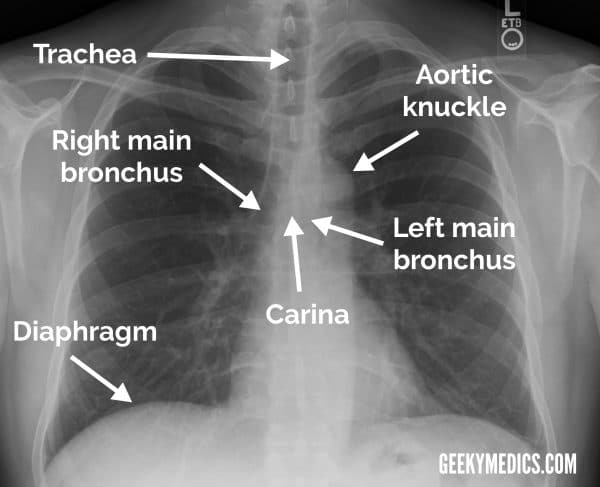
Assessing NG tube placement on a chest X-ray
Confirm key X-ray details
You should first confirm a few key details including:
- Patient name, date of birth and unique patient identifier to make sure it matches that of the patient you are assessing
- Date and time of the X-ray to make sure you are looking at the appropriate radiograph.
Confirm safe placement of the NG tube
To confirm an NG tube is positioned safely, all of the following criteria should be met:
- The chest X-ray viewing field should include the upper oesophagus and extend to below the diaphragm.
- The NG tube should remain in the midline down to the level of the diaphragm.
- The NG tube should bisect the carina.
- The tip of the NG tube should be clearly visible and below the left hemidiaphragm.
- The tip of the NG tube should be approximately 10 cm beyond the GOJ (i.e. within the stomach).
If any of the above criteria are not met and/or you have any doubt about the placement of the NG tube you should seek advice from a senior colleague or discuss with the on-call radiologist.
Incorrect placement of an NG tube
An NG tube can be positioned in the left or right main bronchus but to still appear in the midline (hence why the single criterion of an NG tube appearing in the midline is not satisfactory evidence to confirm safe placement).
An NG tube can curl up on itself, meaning the tip is placed higher than it should be which can result in reflux and aspiration of NG tube contents. This demonstrates the importance of confirming you can see the NG tube tip clearly.
Example of correct NG tube placement
The example below meets the criteria of safe NG placement mentioned previously:
- The chest X-ray field of view is adequate (upper oesophagus down to below the diaphragm)
- The NG tube remains in the midline down to the level of the diaphragm
- The NG tube bisects the carina
- The tip of the NG tube is clearly visible and below the left hemidiaphragm
- The tip of the NG tube is 10 cm beyond the GOJ and therefore is likely to be within the stomach
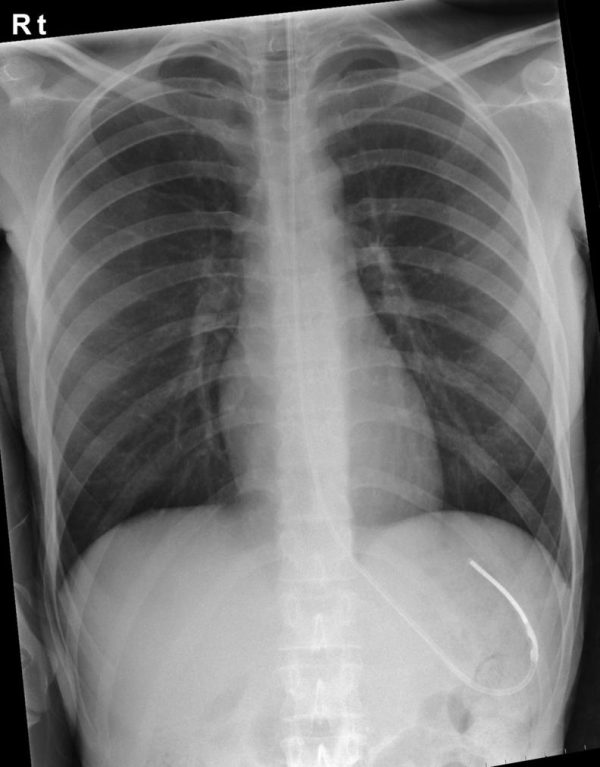
Examples of incorrect NG tube placement
NG tube placed in the left and right main bronchus
This chest X-ray shows an NG tube which has entered the trachea, then the left main bronchus before finally coiling backwards on itself over into the right main bronchus where the tip can be seen.
If we assess this X-ray using the criteria for correct NG tube placement it is clear that it would not be possible to deem this placement as safe:
- The chest X-ray view is adequate (YES)
- The NG tube remains in the midline down to the level of the diaphragm (NO)
- The NG tube bisects the carina (NO)
- The tip of the NG tube is clearly visible and below the left hemidiaphragm (NO)
- The tip of the NG tube is 10 cm beyond the GOJ and therefore likely to be within the stomach (NO)

NG tube placed in the left lung
This chest X-ray demonstrates an NG tube that has entered the trachea, then entered the left main bronchus and then penetrated through the left lung parenchyma and visceral pleural. The NG tube tip has therefore ended up in the pleural space (with an associated pneumothorax). This is an extreme example of misplacement, but it is a good example of why an NG tube tip appearing close to or slightly below the diaphragm alone does not confirm it is in the gastrointestinal tract.
If we assess this X-ray using the criteria for correct NG tube placement it is clear that it would not be possible to deem this placement as safe:
- The chest X-ray view is adequate (YES)
- The NG tube remains in the midline down to the level of the diaphragm (NO)
- The NG tube bisects the carina (NO)
- The tip of the NG tube is clearly visible and below the left hemidiaphragm (NO)
- The tip of the NG tube is 10 cm beyond the GOJ and therefore likely to be within the stomach (NO)
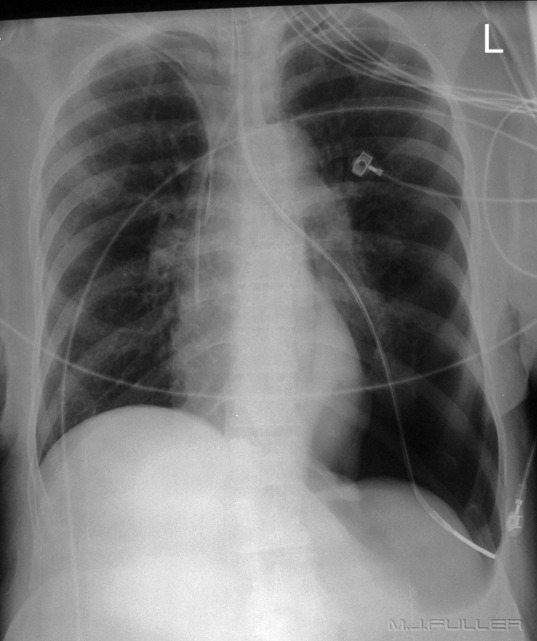
Inadequate insertion length
This chest X-ray shows an NG tube that has been inserted into the oesophagus successfully but to an inadequate length. As a result, although the tip of the NG tube is likely to be within the fundus of the stomach, the aperture through which feed is excreted is most likely still within the oesophagus. NG tubes which are not inserted to an adequate length can result in oesophageal reflux of feed and potentially aspiration. This NG tube would need inserting further and re-assessing with a repeat X-ray to ensure placement was adequate.
If we assess this X-ray using the criteria for correct NG tube placement it is clear that it would not be possible to deem this placement as safe:
- The chest X-ray view is adequate (YES)
- The NG tube remains in the midline down to the level of the diaphragm (YES)
- The NG tube bisects the carina (YES)
- The tip of the NG tube is clearly visible and below the left hemidiaphragm (YES)
- The tip of the NG tube is 10 cm beyond the GOJ and therefore likely to be within the stomach (NO)
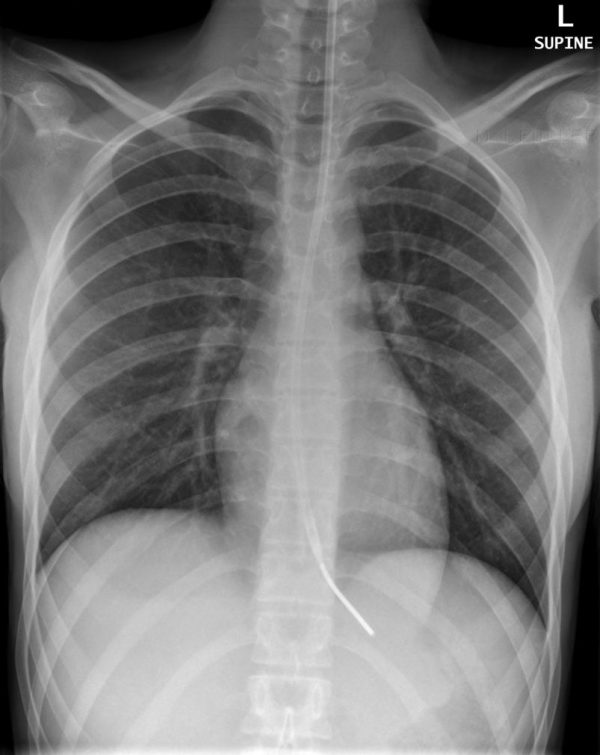
Difficult to see NG tube tip
Sometimes it is very difficult to visualise the NG tube tip and additional wires and/or lines can make the image even harder to interpret, as the example below demonstrates.
If we assess this X-ray using the criteria for correct NG tube placement it is clear that it would not be possible to deem this placement as safe:
- The chest X-ray view is adequate (YES)
- The NG tube remains in the midline down to the level of the diaphragm (YES)
- The NG tube bisects the carina (YES)
- The tip of the NG tube is clearly visible and below the left hemidiaphragm (NO)
- The tip of the NG tube is 10 cm beyond the GOJ and therefore likely to be within the stomach (NO)
If the tip of an NG tube is not clearly visible, you should discuss with the on-call radiologist who may advise:
- Repeating the chest X-ray, possibly with an additional lateral view
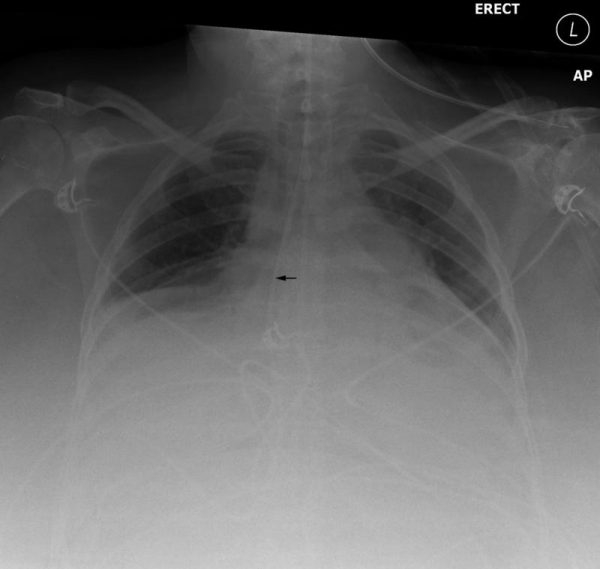
Presenting a chest X-ray for NG tube confirmation
We have provided an example of how you might present your findings after reviewing the position of an NG tube on a chest X-ray.
"This is an AP chest radiograph of an adult [male/female]. The chest X-ray view is adequate and the NG tube can be seen bisecting the carina and remaining in the midline to the level of the diaphragm. The tip of the nasogastric tube is visible below the left hemidiaphragm and is 10cm beyond the gastro-oesophageal junction. Based on these findings, I feel the NG tube is positioned safely. "
References
- NHS Patient Safety Agency. How to confirm the correct position of nasogastric feeding tubes in adults. Published February 2005. Available from: [LINK].
- Marieb EN, Hoehn K (2010). Human anatomy & physiology. San Francisco: Benjamin Cummings. ISBN 0-8053-9591-1.
- Wikiradiography.net. Nasogastric tube position confirmation. Available from: [LINK].
alngindabubabsizarly.blogspot.com
Source: https://geekymedics.com/assessing-nasogastric-ng-tube-placement/#!
